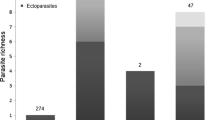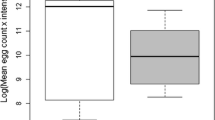Abstract
Alien species are considered a cause of biodiversity loss throughout the world. An important but often overlooked form of competition with native species is the parasite-mediated one. Introduced species may bring their own parasites from their native ranges (spillover) or get native parasites from native species, thus increasing the parasites’ spread and transmission risk (spillback). Thus, a complete knowledge of parasites hosted by introduced species is important to assess and to possibly prevent impacts. Ring-necked and monk parakeets have been introduced in many European countries, where they established a number of alien reproductive populations. We sampled 21 ring-necked parakeets and 7 monk parakeets from Italy and identified 35 arthropod ectoparasites belonging to five species. Amongst those, one species was native to India (Neopsittaconirmus lybartota), where alien populations of ring-necked parakeet may have been originated, and one species from South America (Paragoniocotes fulvofasciatus), which is typically found of the monk parakeet in its native range. The other three species of arthropod parasites were native to Italy and commonly found on native species, suggesting the possibility of spillback processes.

Similar content being viewed by others
References
Aramburù R, Calvo S, Alzugaray ME, Cicchino A (2003) Ectoparasitic load of monk parakeet (Myiopsitta monachus, Psittacidae) nestlings. Ornitol Neotrop 14:415–418
Balbo T, Rossi L, Meneguz PG (1988) Integrated control of Fascioloides magna infection in northern Italy. Parassitologia 31:137–144
Beaucournu JC, Launay H (1990) Les puces de France et du bassin Méditerranéen occidental. Faune Fr :76. Federation FranÇaise des Sociètès de Sciences Naturelles (Eds.), Paris, France
Clay T (1976) Geographical distribution of the avian lice (Phthiraptera): a review. J Bombay Nat Hist Soc 71:536–547
Di Febbraro M, Mori E (2014) Potential distribution of alien parakeets in Tuscany: a bioclimatic model approach. Ethol Ecol Evol 27:116–128
Galiana N, Lurgi M, Montoya JM, López BC (2014) Invasions cause biodiversity loss and community simplification in vertebrate food webs. Oikos 123:721–728
Hulme PE, Pyšek P, Nentwig W, Vilà M (2009) Will threat of biological invasions unite the European Union. Science 324:40–41
Keirans JE, Radovsky FJ, Clifford CM (1973) Argas (Argas) monachus, new species (Ixodoidea: Argasidae), from nests of the monk parakeet, Myiopsitta monachus, in Argentina. J Med Entomol 10:511–516
Kelly DW, Paterson RA, Townsend CR, Poulin R, Tompkins DM (2009) Parasite spillback: a neglected concept in invasion ecology? Ecology 90:2047–2056
Khouri C, Maroli M (2004) La zecca del piccione Argas reflexus (Acari: Argasidae) ed i rischi per la salute umana. Ann Ist Super Sanita 40:427–432
Mack RN, Simberloff D, Lonsdale WM, Evans H, Clout M, Bazzaz FA (2000) Biotic invasions: causes, epidemiology, global consequences, and control. Ecol Appl 10:689–710
McInnes CJ, Coulter L, Dagleish MP, Deane D, Gilray J, Percival A, Willoughby K, Scantlebury M, Marks N, Graham D, Everest DJ, McGoldrick M, Rochford J, McKay F, Sainsbury AW (2013) The emergence of squirrelpox in Ireland. Anim Conserv 16:51–59
Menchetti M, Mori E (2014) Worldwide impact of alien parrots (Aves Psittaciformes) on native biodiversity and environment: a review. Ethol Ecol Evol 26:172–194
Menchetti M, Scalera R, Mori E (2014) First record of a possibly overlooked impact by alien parrots on a bat (Nyctalus leisleri). Hystrix, Ital J Mammal 25:61–62
Mori E, Di Febbraro M, Foresta M, Melis P, Romanazzi E, Notari A, Boggiano F (2013a) Assessment of the current distribution of free-living parrots and parakeets (Aves: Psittaciformes) in Italy: a synthesis of published data and new records. Ital J Zool 80:158–167
Mori E, Ancillotto L, Menchetti M, Romeo C, Ferrari N (2013b) Italian red squirrels and introduced parakeets: victims or perpetrators? Hystrix, Ital J Mammal 24:195–196
Najer T, Sychra O, Literák I, Procházka P, Čapek M, Koubek P (2012) Chewing lice (Phthiraptera) from wild birds in Senegal, with descriptions of three new species of the genera Brueelia and Philopteroides. Acta Parasitol 57:90–98
Nelson RC, Price RD (1965) The Laemobothrion (Mallophaga: Laemobothriidae) of the Falconiformes. J Med Entomol 2:249–257
Novobilský A, Horáčková E, Hirtová L, Modrý D, Koudela B (2007) The giant liver fluke Fascioloides magna (Bassi 1875) in cervids in the Czech Republic and potential of its spreading to Germany. Parasitol Res 100:549–553
Palma RL (1973) Sobre algunos Mallophaga de Aves de la Republica Argentina Insecta. Physis B Aires 3285:483–498
Perez JM, Granados JE, Ruiz I (1995) The morphology of Laemobothrion (Laemobothrion) maximum (Phthiraptera: Laemobothridae). Parassitologia 37:45–51
Picaglia L (1885) Pediculini nuovi del Museo di Zoologia ed Anatomia Comparata della R. Università di Modena. Atti Soc Ital Sci Nat 28:82–90
Prenter J, MacNeil C, Dick JT, Dunn AM (2004) Roles of parasites in animal invasions. Trends Ecol Evol 19:385–390
Price PW, Westoby M, Rice B, Atsatt PR, Fritz RS, Thompson JN, Mobley K (1986) Parasite mediation in ecological interactions. Annu Rev Ecol Syst 17:487–505
Price RD, Hellenthal RA, Palma RL (2003) World checklist of chewing lice with host associations and keys to families and genera. In: Price RD, Hellenthal RA, Palma RL, Johnson KP, Clayton DH (Eds) The Chewing Lice: World Checklist and Biological Overview. Illinois Natural History Survey Special Publication, Champaign-Urbana, Illinois, USA: p 1–448
Romeo C, Wauters LA, Ferrari N, Lanfranchi P, Martinoli A, Pisanu B, Preatoni DG, Saino N (2014) Macroparasite fauna of alien grey squirrels (Sciurus carolinensis): composition, variability and implications for native species. PLoS One 9, e88002
Rushton SP, Lurz PWW, Gurnell J, Nettleton P, Bruemmer C, Shirley MDF, Sainsbury W (2005) Disease threats posed by alien species: the role of a poxvirus in the decline of the native red squirrel in Britain. Epidemiol Infect 134:521–533
Saxena AK, Gupta N, Kumar S, Khan V, Arya G, Saxena S (2009) Intrinsic rate of natural increase of five species of ischnoceran lice (Insecta: Phthiraptera) from India. Entomol News 120:363–369
Scalera R (2001) Il parrocchetto dal collare Psittacula kramer. In: Scalera R (ed) Invasioni biologiche. Le introduzioni di vertebrati in Italia: un problema tra conservazione e globalizzazione. Corpo Forestale dello Stato e Ministero delle Politiche Agricole e Forestali, Rome, pp 195–199
Simberloff D, Martin JL, Genovesi P, Maris V, Wardle DA, Aronson J, Courchamp F, Galil B, Garcìa-Berthou E, Pascal M, Pyśek P, Sousa R, Tabacchi E, Vila M (2013) Impacts of biological invasions: what’s what and the way forward. Trends Ecol Evol 28:58–66
Smit FGAM (1966) Tarsopsylla Wagner, 1927. In: Smit FGAM (ed) Siphonaptera. Insecta Helvetica Catalogum. Imprimerie La Concorde Lausanne, Lausanne, pp 56–57
Smit FGAM (1983) Key to the genera and subgenera of Ceratophyllidae. In: Traub R, Rothschild M, Haddow J (eds) The Rothschild collection of fleas: the Ceratophyllidae: key to the genera and host relationships: with notes on evolution, zoogeography and medical importance. Cambridge University Press/Academic Press, Cambridge, pp 1–36
Strubbe D, Matthysen E (2009) Establishment success of invasive ring‐necked and monk parakeets in Europe. J Biogeogr 36:2264–2278
Whitaker AP (2007) Handbooks for the identification of British Insects, Vol. 1, Part 1b, 2nd edn. Field Studies Council Shrewsbury, Royal Entomological Society of London (Eds.), London, UK
Acknowledgments
We thank S. Martone and M. Scalzo for the parasite collection respectively in Pavia and Follonica, as well as Francesca Manzia and the staff of LIPU’s wildlife rescue centre of Rome for helping in parasite collection in Rome. Fabio Mazzetto and Enrico Busato (University of Turin) kindly took pictures to some parasites. We acknowledge the support provided by European Cooperation in Science and Technology COST Action ES1304 (ParrotNet) for the realisation of this paper. The contents of this paper are the authors’ responsibility and neither COST nor any person acting on its behalf is responsible for the use which might be made of the information contained in it. An anonymous reviewer kindly improved the first draft of this manuscript.
Compliance with ethical standards
All applicable international, national and/or institutional guidelines for the care and use of animals were followed.
Conflict of interest
The authors declare that they have no conflict of interest.
Author information
Authors and Affiliations
Corresponding author
Electronic supplementary material
Below is the link to the electronic supplementary material.
ESM 1
(DOCX 140 kb)
Rights and permissions
About this article
Cite this article
Mori, E., Ancillotto, L., Groombridge, J. et al. Macroparasites of introduced parakeets in Italy: a possible role for parasite-mediated competition. Parasitol Res 114, 3277–3281 (2015). https://doi.org/10.1007/s00436-015-4548-2
Received:
Accepted:
Published:
Issue Date:
DOI: https://doi.org/10.1007/s00436-015-4548-2




